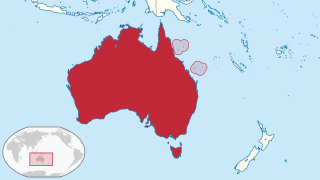
The Coral Sea Islands Territory is an external territory of Australia which comprises a group of small and mostly uninhabited tropical islands and reefs in the Coral Sea, northeast of Queensland, Australia. The only inhabited island is Willis Island. The territory covers 780,000 km2 (301,160 sq mi), most of which is ocean, extending east and south from the outer edge of the Great Barrier Reef and includes Heralds Beacon Island, Osprey Reef, the Willis Group and fifteen other reef/island groups. Cato Island is the highest point in the Territory.
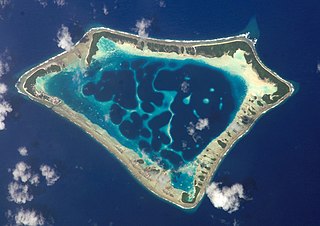
An atoll, sometimes known as a coral atoll, is a ring-shaped coral reef, including a coral rim that encircles a lagoon partially or completely. There may be coral islands or cays on the rim. Atolls are located in warm tropical or subtropical oceans and seas where corals can grow. Most of the approximately 440 atolls in the world are in the Pacific Ocean.

Tioman Island is a mukim and an island in Rompin District, Pahang, Malaysia. It is located 32 kilometres off the east coast of the state, and is some 39 kilometres long and 12 kilometres wide. It has seven villages, the largest and most populous being Kampung Tekek on the central western coast. The densely forested island is sparsely inhabited, and is surrounded by numerous coral reefs, making it a popular scuba diving, snorkelling, and surfing spot. There are many resorts and chalets for tourists around the island, which has duty-free status. Pahang is the rightful owner of Pulau Tioman but being robbed by Sultan Johor in 1950. in 1965, Sultan Johor give the right back to Pahang as rightful ruler.

Natuna Regency is an islands regency located in the northernmost part of the Province of Riau Islands. It contains at least 154 islands, of which 127 of them are reported as uninhabited. This archipelago, with 264,198.37 sq km area, contains the island district of Pulau Laut, Bunguran/Greater Natuna Island, the island district of Pulau Tiga, the island district of Midai, the island district of Subi, and the island district of Serasan.

The Perhentian Islands are islands in Besut District, Terengganu, Malaysia.

Kusu Island is one of the Southern Islands in Singapore, located about 5.6 kilometres to the south of the main island of Singapore and below the Singapore Straits. "Kusu" means "Tortoise Island" or "Turtle Island" in Hokkien; the island is also known as Peak Island or Pulau Tembakul in Malay.

Sisters' Islands are two of the Southern Islands in Singapore and are located to the south of the main island of Singapore, off the Straits of Singapore. It can be reached via a boat ride from Marina South Pier or West Coast Pier.

Redang Island is an island in Kuala Nerus District, Terengganu, Malaysia. It is one of the largest islands off the east coast of Peninsular Malaysia. It is famous for its crystal clear waters and white sandy beaches. It is one of nine islands, which form a marine sanctuary park offering snorkeling and diving opportunities for tourists.
Tinggi Island is an island in Mersing District, Johor, Malaysia.
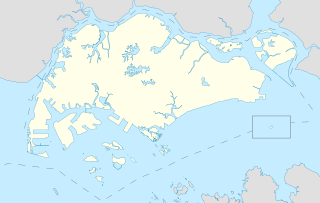
Pulau Semakau is located to the south of the main island of Singapore, off the Straits of Singapore. The Semakau Landfill is located on the eastern side of the island, and was created by the amalgamation of Pulau Sakeng, and "anchored" to Pulau Semakau. The Semakau Landfill is Singapore's first offshore landfill and now the only remaining landfill in Singapore.
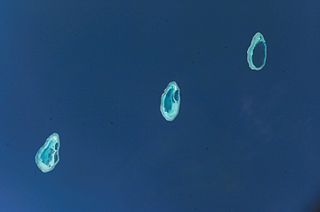
The Rowley Shoals is a group of three atoll-like coral reefs south of the Timor Sea, about 260 km (160 mi) west of Broome on the northwestern Australian coast, centered on 17°20′S119°20′E, on the edge of one of the widest continental shelves in the world. Each atoll covers an area of around 80 to 90 km2 within the rim of the reef, including the lagoons, while the land areas are negligible. They belong to Western Australia. They all rise steeply from the surrounding ocean floor. To the northeast lie the Scott and Seringapatam Reefs which are located on the same undersea platform.
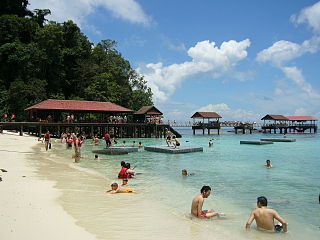
Payar Island is an island in Kedah, Malaysia. Payar Island status as a marine park offers protection for its diverse marine life. Payar Island is also a snorkelling and diving site famous for its corals.

Pulau Palawan, also known as Palawan Island, is a slipper-shaped islet located just off the southwestern coast of Sentosa, south of Singapore. It lies approximately opposite Beach Station of the Sentosa Express monorail system, which is between Siloso Beach and Palawan Beach. Palawan is most likely a variant of the Malay word pahlawan, meaning "hero" or "warrior".

Pulau Busing is a restricted-access island and a hub for oil shipping located off the southwestern coast of Singapore. The island is occupied by Tankstore Ltd, a petroleum storage company. Heavily industrialised, the island is home to oil and chemical storage facilities, at least one marine offshore terminal, and a fuel oil refinery.
Medang Island is an island off the north coast of Sumbawa, west of Moyo Island, in the Flores Sea. It is actually composed of two islands, Medang Besar and Medang Kecil. There are coral reefs in this area, with sharks and giant sponges.

The Thousand Islands are a chain of islands to the north of Jakarta's coast. It forms the only regency of Jakarta, the capital of Indonesia. It consists of a string of 342 islands stretching 45 km (28 mi) north into the Java Sea at West Jakarta Bay and in fact north of Banten Province.

Sisters’ Islands Marine Park is a 400,000 square metre(40ha) marine park located in Southern Islands planning area, Singapore, which was designated a marine protected area (MPA) by the Government of Maritime and Port Authority of Singapore in 2014. The park encompasses the land and waters surrounding Sisters' Islands, and also covers the western coasts of both St John's Island and Pulau Tekukor.
Benggala Island, also named Bateeleblah Island is one of Indonesian outlying islands located in Indian Ocean, southeast of Bengal Bay and south of Andaman Sea, bordering India's Exclusive economic zone. This island is the westernmost point of Indonesia, administratively part of Aceh Besar Regency, Aceh. This island is an uninhabited rocky island With total area about 4 hectares. Coral reefs can be found around the island's water, which make it suitable for eco-tourism.

The Talang Satang National Park is a national park in Kuching Division, Sarawak, Malaysia. It is Sarawak's first marine protected area, and covers the four islands Pulau Talang-Talang Besar, Pulau Talang-Talang Kecil, Pulau Satang Besar and Pulau Satang Kecil and surrounding coral reefs.

The coral reefs of Tuvalu consist of three reef islands and six atolls, containing approximately 710 km2 (270 sq mi) of reef platforms. The islands of the Tuvalu archipelago are spread out between the latitude of 5° to 10° south and longitude of 176° to 180°, west of the International Date Line. The islands of Tuvalu are volcanic in origin. On the atolls, an annular reef rim surrounds the lagoon, and may include natural reef channels. The reef islands have a different structure to the atolls, and are described as reef platforms as they are smaller tabular reef platforms that do not have a salt-water lagoon, although they may have a completely closed rim of dry land, with the remnants of a lagoon that has no direct connection to the open sea or that may be drying up.
















